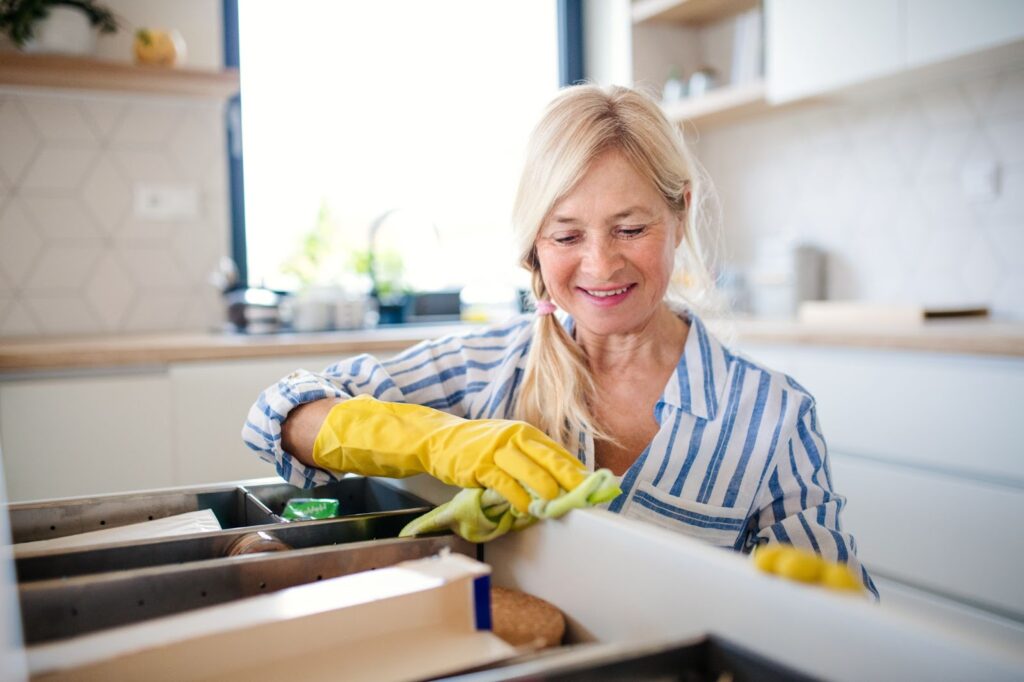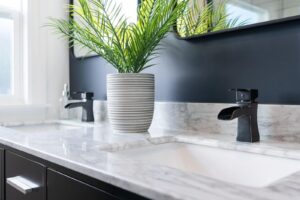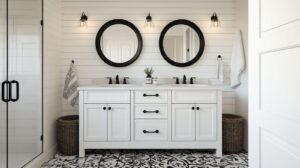When you’re giving your home a good scrub, cleaning painted cabinets should be high on your list. Whether in your kitchen or bathroom, cabinets collect dust, grease, and fingerprints fast. While cabinets don’t get as dirty as countertops, they still take a beating from everyday use — especially in busy homes with kids or frequent cooking.
Regular maintenance keeps your cabinets looking bright and helps the paint last longer. Dirt and oils dull the finish over time, and moisture may lead to bubbling or chipping. Learning how to clean painted cabinets properly protects your investment.
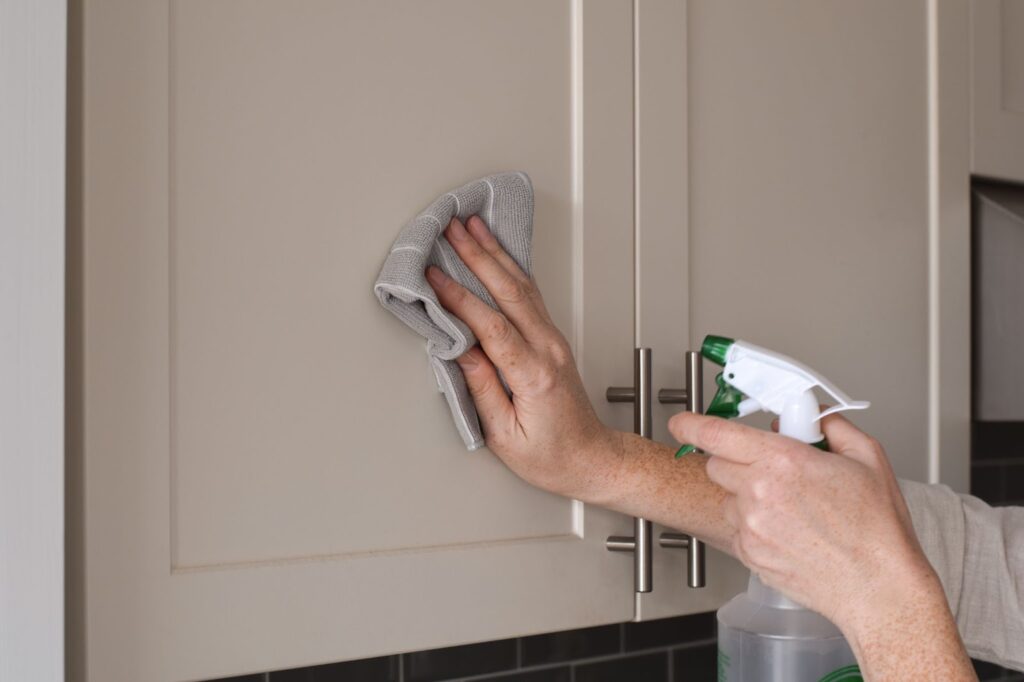
How often should you clean painted cabinets?
How often you clean depends on how much you use your kitchen or bathroom. A weekly wipe-down is ideal for removing light dust and splatters, while a deeper clean every few months keeps buildup under control. Homes with more cooking, pets, or little hands touching everything may require more frequent attention.
For everyday upkeep, simply use a soft microfiber cloth to wipe your painted kitchen cabinets with warm water. Every few weeks, use a mild dish soap solution to cut through grease and restore shine. Deep cleaning once or twice a year helps prevent stubborn grime and discoloration, especially around handles, drawers, and lower cabinets, where fingerprints and spills tend to accumulate.
What to avoid when cleaning painted surfaces
Most painted bathroom cabinets have a semi-gloss or satin finish, which makes them easier to wipe down than flat paint. Still, even the most durable finishes get damaged by harsh products or scrubbing too aggressively.
When cleaning painted bathroom cabinets, avoid using cleaners containing ammonia, bleach, or strong acids. These dull the paint or cause it to peel over time.
Avoid abrasive scrubbers, such as steel wool or melamine sponges. While those tools work well on stubborn surfaces like tile or tubs, they’re too rough for painted finishes. Instead, use soft microfiber cloths or gentle sponges that won’t scratch.
Also, resist the urge to soak cabinets or leave them wet for long periods. Too much water can seep into seams and edges, causing the paint to bubble or crack. Be gentle when wiping down painted cabinets.
The best method for cleaning painted cabinets
Once you know what to avoid, cleaning your cabinets is simple. The best part is that you probably already have everything you need at home.
Supplies you’ll need
- Bucket or large bowl
- Warm water
- Mild dish soap (great for cutting grease)
- Microfiber cloths or soft sponges
- Dry towels
- Step stool for hard-to-reach areas
Step-by-step process
- Fill your bucket with warm water and add a small amount of dish soap. Most soaps are concentrated, so a few drops go a long way.
- Dip your microfiber cloth in the soapy water, then wring it out so it’s damp, not soaking.
- Gently wipe each cabinet door in a circular motion, working from top to bottom. This helps avoid drips.
- Rinse your cloth often to remove grease and grime as you go.
- Once clean, use a second cloth dampened with plain water to remove any remaining soap residue.
- Dry the surface with a soft towel to prevent streaks or water damage.
For taller or hard-to-reach cabinets, use a step stool to make sure you can reach the top edges.
How to tackle stubborn stains or grease buildup
Even with regular cleaning, grease and fingerprints sometimes hang on. When that happens, a few simple tricks help lift buildup without harming your paint.
Start with a mixture of warm water and a small amount of dish soap. If grease remains, mix one part vinegar with one part water in a spray bottle. Lightly mist the surface, then wipe with a soft cloth. This mild solution breaks down residue while keeping painted kitchen cabinets safe from harsh chemicals.
For sticky spots, sprinkle a little baking soda on a damp cloth and gently rub in a circular motion. Always test a small, hidden area first to ensure the paint finish is satisfactory. Pat the surface dry with a clean towel once it feels smooth again. Taking your time and using gentle methods is the best approach.
Natural and commercial cleaners that work safely
You don’t need fancy products for cleaning painted cabinets — but you do need the right ones. Natural options, such as diluted vinegar or mild dish soap, are great for everyday cleaning, while baking soda helps with more stubborn spots. For homeowners who prefer store-bought options, opt for gentle, pH-balanced cleaners specifically designed for use on wood or painted finishes.
Always check the label to confirm that the cleaner is safe for painted kitchen cabinets. Avoid anything labeled heavy-duty or degreasing unless it specifically says it’s safe for painted surfaces. Spraying the cleaner directly onto the cabinet isn’t recommended; instead, apply it to a cloth first to avoid soaking the surface.
Many people also prefer eco-friendly cleaners made with plant-based ingredients. These protect your cabinets while reducing harsh fumes, which is a nice bonus if you’re doing a thorough deep clean of your bathroom or kitchen.
Preventing damage and keeping cabinets looking new
Regular cleaning of painted cabinets is only half the battle — protecting them from damage keeps them looking fresh longer. The simplest habit is wiping away spills and splatters as soon as they happen. Food residue, grease, and water droplets may stain or soften the paint if left too long.
Using cabinet handles instead of touching the doors helps prevent oils from your hands from dulling the finish. It’s also smart to keep humidity under control, especially in kitchens and bathrooms. Too much moisture causes the paint to bubble, crack, or peel.
If you want to go the extra mile, apply a light coat of furniture wax or polish every few months to add a layer of protection. Small steps like these can extend the life of your cabinets and make cleaning painted cabinets quicker and easier down the road.
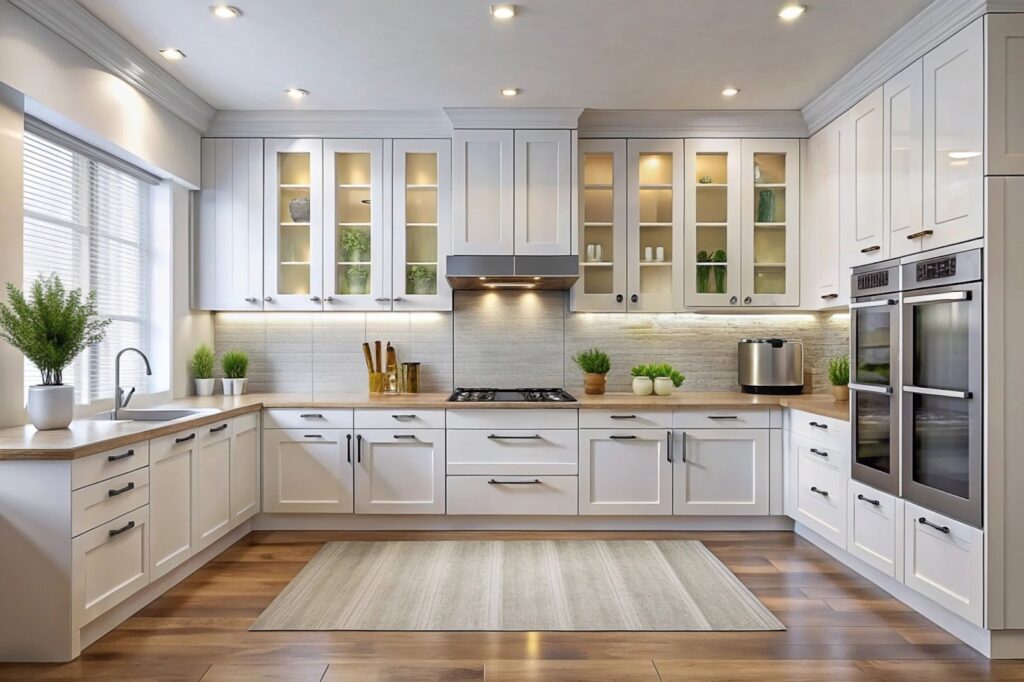
When it’s time to refresh or repaint your cabinets
Even with the best care, painted bathroom cabinets or kitchen cabinets eventually show signs of wear. You may notice small chips, fading color, or dull paint despite regular cleaning. When this happens, a refresh can make your entire kitchen or bathroom feel new again.
If you love your current layout, consider lightly sanding and repainting it instead of replacing it. Cleaning painted cabinets properly helps prepare them for a repaint by removing grease and residue that would prevent new paint from sticking evenly.
For deeper wear, such as peeling, warped panels, or water damage, replacement may be a better investment.
Mountain States Kitchen and Bath can help
Keeping up with cleaning painted cabinets is one of the easiest ways to refresh your kitchen or bathroom without a major renovation. A few minutes of care can help preserve color, prevent damage, and keep your home looking bright. But sometimes, you’re ready for more than a clean — you’re ready for a full update.
When that time comes, Mountain States Kitchen and Bath is here to help. Our experienced team will guide you through refinishing, repainting, or even replacing your kitchen cabinets with fully customized options. If you’re ready to redesign your space, we’ll help you find the perfect solution for your home.
Schedule a consultation with Mountain States Kitchen and Bath today to start transforming your kitchen or bathroom into a space you’ll love for years to come.

